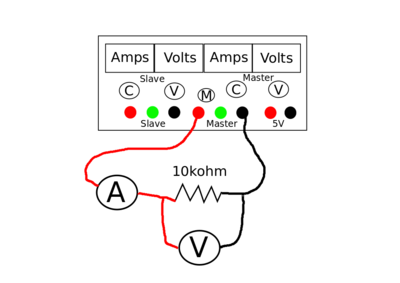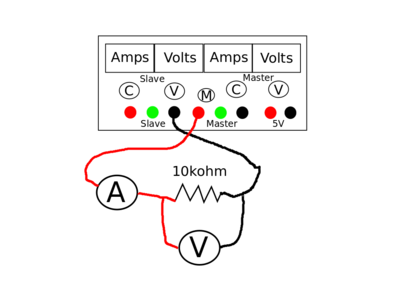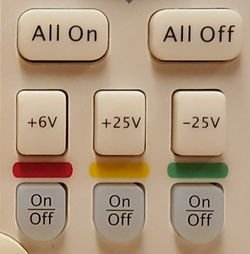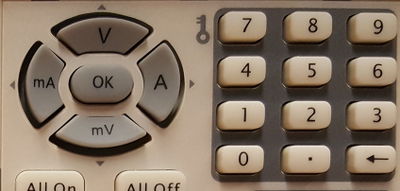Power Supplies
This module will teach you how to use both analog and digital power supplies. While there will be different power supplies in the world in which you will interact, this will gain you the basic knowledge of power supplies to be able to handle any power supply you come across.
The analog power supply we will work with is the model HY3003D-3 and information can be found in this data sheet or user manual. It is important to note that many different manufacturers will make the HY3003D-3 model of regulated analog power supply. While the interface might be different, the circuit diagram is the same.
The digital power supply used is the Rigol DP1308A and information can be found here, specifically under the documents tab and looking at either the data sheet or user manual.
For this module, you will need:
- Rigola DP1308A digital DC Power Supply
- HY3003D-3 analog DC Power Supply
- 2 Fluke 179 True RMS multimeters
- An assortment of short wires
- Resistors: 4x100ohm and 1 10kohm
- A breadboard (or protoboard)
- BNC-Banana Plug Adaptor (with male BNC plug)
- BNC Cables
This module assumes some familiarity with the Multimeters and detail will not always be explained when using these devices.
This module is part of the General Lab Equipment Obstacle Course.
Floating and Grounding
It is important to first discuss the difference between a floating power supply and a grounded power supply.
Ground is a physical connection to the earth (ground). For American three pronged outlets, the extra little third prong will attach to ground.
Floating circuits will have a point of lowest potential, but this value could be anything relative to ground. This is what occurs for American two pronged outlets and batteries. Floating can be used to change voltages when there is already a high voltage occurring. For example boosting 1000V to 1020V, where as a grounded supply would attempt to jump 1000V directly to ground.
Analog Power Supply
This section will cover use of the HY3003D-3 analog DC Power Supply. First discuss the basic nature of the power supply and then discuss the three operating modes.
General Analog Power Supply Information
The HY3003D-3 analog power supply has meaning to its name, breaking into parts HY-30-03-D-3
- HY- Brand/manufacturer
- 30- Maximum output voltage (30 volts)
- 03- Maximum output current (3 Amps)
- D- Display type (LCD)
- 3- Number of outputs (3)
There are three outputs on the analog power supply-
- Floating Constant 5V Output
- Master Output
- Slave Output
The 5V output gives out a constant 5V (surprisingly). There are three modes in which the power supply can operate: independent, series and parallel. In independent mode, the master and slave descriptions mean nothing. Only while operating in the series or parallel mode will the master control the slave. In those modes, only the controls for the master will function and it will control both supplies simultaneously.
Constant 5V Output
We will first discuss the constant 5 volt output. First to explore, we use the multimeter in resistance mode to find the internal resistance of the constant power 5V power supply. With the power off, measure the resistance from the positive terminal (red) and the negative terminal (black) of the .
- What resistance do you read across the constant voltage supply? Does this seem reasonable?
This value is important to know, as the internal resistance of the power supply can affect the desired output of the power supply depending on your load circuit. Now measure the resistance between the positive terminal of the constant power supply and ground (a green terminal)
- What resistance do you read? Does this make sense?
The 5V supply by default is a floating supply, so there should be no connection to ground. If we wanted a ground 5 Volt supply, we could connect the negative (black) terminal to the ground (green) with a wire (banana or otherwise).
Operating in Independent Mode
In the center of the panel, you will find the dial/buttons (depending on model) for the operation mode of the analog power supply. For this section, make sure that you are operating in independent mode. In this mode, the two internal power supplies are independent and can be controlled individually.
For each supply, you should be able to identify the current control knob, voltage control knob and three terminals for the voltage (red positive, black negative and green ground).
- What resistance do you read from the positive terminal to the negative terminal of one of the supplies? Does this seem reasonable?
- What resistance do you read from the positive terminal to the negative terminal of the other supply? Are they the same?
- What resistance do you read from the positive terminal to ground? The negative terminal to ground? Does this make sense?
Be default, both supplies are floating. We could connect the negative (black) terminal to the ground (green) with a wire (banana or otherwise) if a grounded power source was required.
- What resistance do you read from the positive terminal of one supply, to the positive terminal of the other supply? Does this make sense?
Even though we are in independent mode, there is still a connection between the two internal supplies. The resistance is very high, so unless the resistance of the circuit load is very high, this should be okay.
- What resistance do you read from the positive terminal of one supply, to the positive terminal of constant 5V supply? Does this make sense?
The 5V supply is not connected in any way to the other two supplies.
We will now move to discuss the different modes the analog power supply can operate in.
Voltage Supply
To explore this, you will set up a very basic circuit to test the power supply. Simply put a voltage across a 100ohm resister as shown. To verify the operation of the power supply, we also want to include a ammeter in the circuit and a voltmeter across the resistor. Either power supply can be used for this section; the controls work the same for both.
With the power off, turn the current control knob all the way clockwise. This will allow for the maximal current to by supplied by the power supply. The voltage control knob should be turned all the way down by turning it all the way counter-clockwise. Turn on the power supply! Adjusting the voltage knob will change the voltage output. The display will show the voltage in Volts. Set the voltage to 7.5V.
- What voltage do you read in the voltmeter? Is it the same as the reading on the power supply?
- What current does the display read?
- What current does the ammeter read? Is it the same as the power supply?
If you turn up the voltage too high, you will burn out the resistor! We can protect delicate circuits with the current control knob. We will be discuss current limiting below.
Replace the 100ohm resistor with the 10kohm resistor and turn the voltage knob to the max.
- What voltage do you read in the voltmeter? Is it the same as the reading on the power supply?
- What current does the display read?
- What current does the ammeter read? Is it the same as the power supply?
In this case, the load can sustain all the current and we max out at the voltage of the power supply. We will now move to discuss the using the power supply as a current source.
... turn off the power supply.
Current Supply
To explore this, we use a slightly different circuit. Put 4 100ohm resisters in parallel then power across the parallel circuit. To verify the operation of the power supply, we also want to include a ammeter in the circuit and a voltmeter across the resistor. Either power supply can be used for this section; the controls work the same for both.
With the power off, turn the voltage control knob all the way clockwise. This will allow for the maximal voltage to by supplied by the power supply. The current control knob should be turned all the way down by turning it all the way counter-clockwise. Turn on the power supply! Adjusting the current knob will change the current output. The display will show the current in Amps. Set the current to 0.3A.
- What current do you read in the voltmeter? Is it the same as the reading on the power supply?
- What voltage does the display read?
- What voltage does the ammeter read? Is it the same as the power supply?
If you turn up the current too high, you will burn out the resistors! When operating in this mode is in important to know the current limit of the load you are using.
Now start adjusting the voltage knob counter clockwise, observing the voltage reading as it goes.
- What happens? Why is this?
This idea is the basics behind the current limiting function of the power supply. The current knob can be set to the desired maximal current and then the voltage can be varied.
Return the current to zero and the voltage to the max. Replace the parallel circuit with a 10kohm resistor.
- What happens if you try to increase the current now? Why is this?
Each individual supply can only give 30V. We will discuss how to get more voltage by operating in the series mode.
...Turn off the power supply
Current Limited Protection Mode
These power supplies can be operated in a current limited mode in order to protect the load from high currents. This section will describe how to set a current limit before the power supply has been connected to the load.
With the supply off and nothing connected to the power supply, turn the current control all the way to the max and the voltage control to the minimum. Turn on the power. We want to adjust the adjust the voltage control to the voltage we will be using (or the maximum voltage). At this point set it to 10V. Now connect the positive and negative terminal with a thick banana wire. We can now adjust the current to our desired limit with the current control knob. Set it to 0.3A. Unplug the banana wire and turn the voltage all the way down. Now attach the parallel circuit from the current source section. Start upping the voltage now that the circuit is connected.
- What happens? Why is this?
This is the safest and most effective way to protect a circuit before it is ever connected to the power supply.
...Turn off the power supply
Operating in Series Mode
Switch the center switch to series mode. This will vary depending on the model you are using. In this mode the two supplies will become linked in series allowing for a greater voltage output.
With the power off, connect the negative terminal of the slave to one end of a 10kohm resistor and the positive terminal of the master to the other end of the resistor. This will connect across both supplies. Adjust both slave knobs and the master's current control to the maximum value (clockwise) and the master's voltage knob to zero.
- Which mode are we operating in?
Turn on the power supply. Start adjusting the master voltage and observe the voltage displays.
- What do you notice about the voltage displays?
- What is the maximal voltage you can get?
- What do you think the voltage across the resistor is?
Set the voltage on the master display to 5 volts. Get your multimeter handy and get ready to measure some voltages.
- Measure the voltage across the resistor, what it is?
- Measure the voltage from the positive terminal of the master to the negative terminal of the master, what it is? Does this make sense?
- Measure the voltage from the positive terminal of the master to the positive terminal of the slave, what it is? Does this make sense?
- Measure the voltage from the positive terminal of the slave to the negative terminal of the slave, what it is? Does this make sense?
Each supply still creates its individual voltage, and the total of those can be utilized by treating them as one supply with the master's positive terminal and the slave's negative terminal. The thing to remember is that the total voltage will be the sum of the displays.
Turn down the voltage to zero. Now remove the 10kohm resistor from the circuit and replace it with the 4 100 kohm resistors in parallel. Now make the voltage across the resistors 4 volts (2 volts on each display). Adjust the slave voltage knob all the way down and back up. Then do the same with the slave current control.
- What happens when the slave voltage is adjusted?
- What happens when the slave current is adjusted?
- Why do you think it works this way?
The master completely controls the voltage in this mode, so the slave voltage control has been disabled. The slave current control can still be used to limit the current, but the master still continues to operate. Make sure the slaves controls are both set to maximum. Now adjust the master current control.
- What happens when the current control kicks in?
In this case, the master current control will also control the slave's current as well as the voltage. With this in mind, the series power supply can and should be operated using only the master controls. If a current source was wanted, everything can be done with the master controls.
Operating in Parallel Mode
Operating in parallel mode allows for a high current output. The power supplies will be linked in parallel with each other. Again in this case, the slave controls should be opened to the max, and all adjustments to the current or voltage should be down with the master controls. The load can go across either the slave or master terminals, but it is suggested to use the master terminals.
In this mode, the maximum voltage remains 30V, but the maximum current will be 6A. As this is a high current that would require many resistors in parallel to get the current without burning out the resistors, we do not test this limit here.
In this mode, the parallel supply can be used in either current or voltage limiting mode using the techniques given above.
Digital Power Supply
This section will cover use of the Rigol DP1308A digital DC Power Supply. First discuss the basic nature of the power supply and then discuss the three operating modes.
General Analog Power Supply Information
Rigol DP1308A digital DC Power Supply doesn't seem to have as clear of a meaning to its specification number. There are three outputs on the digital power supply-
- Independent 6V/5A Output (red)
- Common 25V/1A Output (yellow)
- Common -25V/1A Output (green)
The 6V supply is isolated from the from the other two outputs for pure independent sources if needed. The two common port supplies have the same reference point for zero voltage. One supply will give positive voltages from that zero, while the other goes more negative. This can be considered the two supplies being connected in series as above for the analog circuits.
Again all the outputs are floating by default. There is a ground terminal on the front that can be used to ground the terminals if desired. Remember that if this is to be used to connect to the negative terminals as marked on the power supply.
Front panel controls
At first changing the voltage and current for the supplies can seem odd and cumbersome, so we will first familiarize ourselves with the controls. Directly to the right of the display, you'll notice the buttons shown to the right. With these controls, you are able to select which supply you will be controlling with the +6V, +25V and -25V buttons. With the power on, try selecting the different outputs.
- Looking at the display, how can you tell which one is active?
Above the output selection are the buttons for turning on/off all the supplies at the same time. Press the All on button.
- What happens? Why do you think they would prompt this?
Select cancel using the button directly under cancel on the display. Typically turning all the supplies on is not the best idea unless you are sure everything is setup correctly. Lets go ahead and select the 6V supply. Now press the on/off button directly below it to turn it on.
- How can we tell the supply is turned on?
- Is there more than one way to tell?
Go ahead and turn off the 6V supply. We will move to discuss how to set the voltages and currents for the outputs. You should notice at the bottom of the display the words Volt, Curr, O.V.P. and O.C.P.
- Which one is light up? What do you think this means?
The buttons below each of those will allow to to set the voltage, current, over voltage protection and over current protection, respectively.
If we want to set the voltage, there are two ways to do it:
- Adjusting the value with the cursor.
- Setting the value directly.
First, we will use the cursor to set it. Select Volt to set the voltage. You will notice a little white box in the lower smaller voltage. The location of the box can be moved using the left and right arrows on the grey dial to the right of the display. The value of the box can be shifted up and down using the up and down arrows. Try setting the voltage to 0.5V and 1A. Remember that to switch to current, you'll need to select it using the display.
Now we use the number pad to set the voltage and current. This is done by typing the value into the keypad, then selecting the units you wish to use. To select the units, you can either use the grey buttons that were used to adjust previously. Or using the buttons below the display.
- Do you have to have the current selected to change the current with this method?
- Which method do you perfer to use?
We will discuss the over protection functions later, but for now know that they can be set in the same manner as for the voltage and current.







